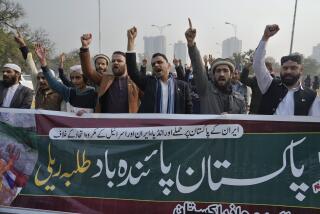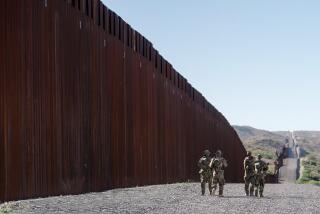Change on Afghan border
FORWARD OPERATING BASE SALERNO, AFGHANISTAN — In the enveloping darkness of a starless summer night, the sizzle-thump of incoming Taliban rockets is swiftly answered by the percussive boom of outgoing U.S. artillery. But the American troops manning this base in eastern Afghanistan know that their elusive nighttime foe can slip away to sanctuary in Pakistan, just 20 miles away.
The militants firing rockets at this installation, informally known as Camp Salerno, in all likelihood traveled here from Pakistan’s tribal areas, home turf of several major Taliban commanders and their militias. The flow of fighters and arms into Afghanistan from Pakistan -- and the tribal belt’s use as a fighter haven -- has long been a key concern of U.S. and other Western officials.
During a visit to the region last week, U.S. national security advisor James L. Jones Jr. urged Pakistan to press ahead with a long-delayed army offensive against Taliban fighters who had become entrenched in the country’s northwest.
So far, though, the Pakistani military campaign has been centered on the Swat Valley, far from the border zone, and the tribal areas remain a wellspring of insurgent activity: suicide attacks, roadside explosive devices, vehicle bombs.
The frontier itself remains a magnet for violence; this week, a suicide attacker struck a crossing at Torkham, a major gateway into Afghanistan, killing a policeman, wounding several civilians and setting the checkpoint ablaze.
American commanders, however, believe a greater concentration of U.S. and Afghan troops in the border region is beginning to change the equation. The “battle space” overseen from Camp Salerno -- the Afghan provinces of Khowst, Paktia and Paktika -- now contains more U.S. forces than at any point during the nearly 8-year-old war. A buildup ordered by the Obama administration will bring the number of U.S. troops in Afghanistan to a record 68,000 by year’s end.
The mandate to give chase to the insurgents, at least using Western ground troops, stops at the rugged, mountainous border. Just across from Khowst and Paktika lie two of the most insurgent-plagued of Pakistan’s tribal areas, North and South Waziristan.
Pakistani army commanders, after years of looking the other way while militants had free rein in the tribal areas, are in the early stages of what is billed as a major assault on South Waziristan, the redoubt of the leader of the Pakistani Taliban, Baitullah Mahsud.
Pakistani officials say Mahsud, who is accused of masterminding a campaign of suicide bombings in Pakistan and the assassination of onetime Prime Minister Benazir Bhutto, narrowly escaped a missile attack last week believed to have been carried out by drones, the main U.S. weapon for reaching across the border from Afghanistan. Dozens of other militants were killed in the strike.
U.S. military officials last week said they were seeing signs that stepped-up Pakistani operations were reducing the overall flow of weapons and militants into Afghanistan. But that has yet to translate into a significant overall drop-off in casualties among Western and Afghan troops, together with Afghan civilians, as a result of insurgent attacks.
The Pakistani military offensive so far has skirted North Waziristan, home ground of one of the most notorious insurgent groups, the Haqqani network. It is believed responsible for most major attacks in a wide arc of eastern Afghanistan, including Khowst province.
Despite pressure on the Pakistani side of the border -- including not only the Pakistani military offensive, but U.S. drone attacks and intertribal rivalries -- insurgents continue to make their way back and forth across the thinly guarded frontier. But their comings and goings do not go unobserved.
“We know who they are, and we know where they come from,” said a U.S. military official familiar with intelligence on cross-border movement of Taliban commanders, foot soldiers and armaments. The official requested anonymity, citing the sensitivity of the intelligence involved.
Afghanistan’s border police force, which is being trained by U.S. mentors, has had some recent successes in tracking and interdicting fighters and weapons. Still, the frontier has dozens of mountain passes and goat-track pathways, all well known to the Pashtun tribes from which the ranks of the Taliban are mainly drawn.
“You can’t make some kind of human chain-link fence,” said U.S. Army Capt. Philip Poag, who has been helping train the Afghan border police.
American forces in Camp Salerno’s command area have been pushing into remote districts long used by insurgents as infiltration routes, uncovering encampments and weapons caches as they go.
Several weeks ago, American and Afghan troops made a rare find: a Taliban rest-and-resupply stop in a remote part of Paktika province that was filled at the time with militants arriving from Pakistan. Indications were that it had been in use for some time, perhaps several years, as a training camp and logistics hub.
Staging a swift attack before the fighters there could move on, coalition forces killed 27 militants and seized a large cache of rocket-propelled grenades and other weapons.
This week, Afghan and U.S. forces laid siege to what they described as Haqqani “command bunkers” in Khowst, killing more than a dozen militants in airstrikes.
More difficult to predict and prevent, however, are attacks against civilians. Last week, a suicide attacker killed seven people outside a mosque in Khowst, the provincial capital and the city that lies closest to Camp Salerno.
That attack came as Khowst was still reeling from an hours-long siege on May 12, when a squad of suicide bombers hit municipal offices and the governor’s compound, among other targets. The next day, insurgents set off a powerful vehicle bomb at the gates of the base, killing seven civilians.
“They look for the soft targets,” said Army Maj. Matthew Gregory, a spokesman for Task Force Yukon, based at Camp Salerno. “It’s hard for them to get to us, so they go after civilians.”
The base itself, like many of those close to the border, is rocketed by insurgents. At night, light restrictions are in effect to make it harder for militants to take aim, plunging the camp into near-total darkness. Still, rockets do occasionally strike inside the base.
Even the most ambitious assaults by insurgents, including a carefully synchronized attack in August employing a wave of half a dozen suicide bombers, have failed to penetrate the camp’s perimeter. But townspeople in Khowst say they draw little comfort from the presence of a heavily fortified U.S. installation if they themselves feel unsafe.
“We understand what they are trying to do,” said shopkeeper Zabiullah Khan, whose teenage son was injured in last week’s attack near the mosque. “But we don’t have guns and armor. It’s not enough for them to protect themselves; they must protect us as well.”
--
More to Read
Sign up for Essential California
The most important California stories and recommendations in your inbox every morning.
You may occasionally receive promotional content from the Los Angeles Times.










